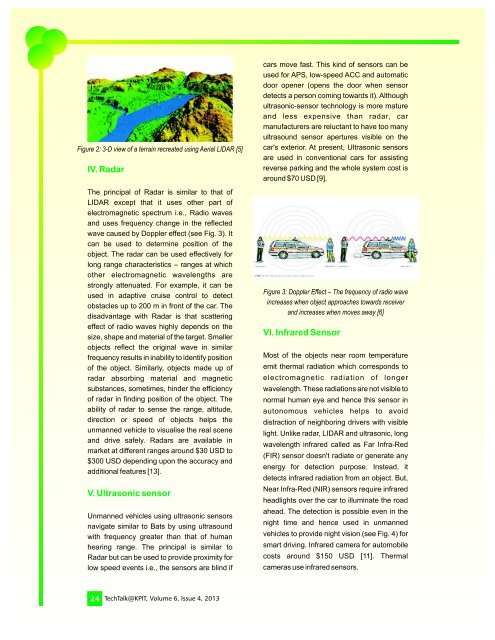Autonomous Vehicles - KPIT
Autonomous Vehicles - KPIT
Autonomous Vehicles - KPIT
You also want an ePaper? Increase the reach of your titles
YUMPU automatically turns print PDFs into web optimized ePapers that Google loves.
Figure 2: 3-D view of a terrain recreated using Aerial LIDAR [5]<br />
IV. Radar<br />
The principal of Radar is similar to that of<br />
LIDAR except that it uses other part of<br />
electromagnetic spectrum i.e., Radio waves<br />
and uses frequency change in the reflected<br />
wave caused by Doppler effect (see Fig. 3). It<br />
can be used to determine position of the<br />
object. The radar can be used effectively for<br />
long range characteristics – ranges at which<br />
other electromagnetic wavelengths are<br />
strongly attenuated. For example, it can be<br />
used in adaptive cruise control to detect<br />
obstacles up to 200 m in front of the car. The<br />
disadvantage with Radar is that scattering<br />
effect of radio waves highly depends on the<br />
size, shape and material of the target. Smaller<br />
objects reflect the original wave in similar<br />
frequency results in inability to identify position<br />
of the object. Similarly, objects made up of<br />
radar absorbing material and magnetic<br />
substances, sometimes, hinder the efficiency<br />
of radar in finding position of the object. The<br />
ability of radar to sense the range, altitude,<br />
direction or speed of objects helps the<br />
unmanned vehicle to visualise the real scene<br />
and drive safely. Radars are available in<br />
market at different ranges around $30 USD to<br />
$300 USD depending upon the accuracy and<br />
additional features [13].<br />
V. Ultrasonic sensor<br />
Unmanned vehicles using ultrasonic sensors<br />
navigate similar to Bats by using ultrasound<br />
with frequency greater than that of human<br />
hearing range. The principal is similar to<br />
Radar but can be used to provide proximity for<br />
low speed events i.e., the sensors are blind if<br />
cars move fast. This kind of sensors can be<br />
used for APS, low-speed ACC and automatic<br />
door opener (opens the door when sensor<br />
detects a person coming towards it). Although<br />
ultrasonic-sensor technology is more mature<br />
and less expensive than radar, car<br />
manufacturers are reluctant to have too many<br />
ultrasound sensor apertures visible on the<br />
car's exterior. At present, Ultrasonic sensors<br />
are used in conventional cars for assisting<br />
reverse parking and the whole system cost is<br />
around $70 USD [9].<br />
Figure 3: Doppler Effect – The frequency of radio wave<br />
increases when object approaches towards receiver<br />
and increases when moves away [6]<br />
VI. Infrared Sensor<br />
Most of the objects near room temperature<br />
emit thermal radiation which corresponds to<br />
electromagnetic radiation of longer<br />
wavelength. These radiations are not visible to<br />
normal human eye and hence this sensor in<br />
autonomous vehicles helps to avoid<br />
distraction of neighboring drivers with visible<br />
light. Unlike radar, LIDAR and ultrasonic, long<br />
wavelength infrared called as Far Infra-Red<br />
(FIR) sensor doesn't radiate or generate any<br />
energy for detection purpose. Instead, it<br />
detects infrared radiation from an object. But,<br />
Near Infra-Red (NIR) sensors require infrared<br />
headlights over the car to illuminate the road<br />
ahead. The detection is possible even in the<br />
night time and hence used in unmanned<br />
vehicles to provide night vision (see Fig. 4) for<br />
smart driving. Infrared camera for automobile<br />
costs around $150 USD [11]. Thermal<br />
cameras use infrared sensors.<br />
24 TechTalk@<strong>KPIT</strong>, Volume 6, Issue 4, 2013


